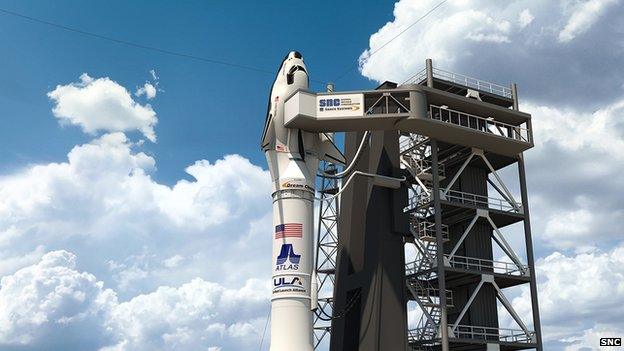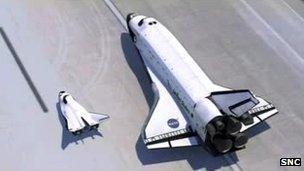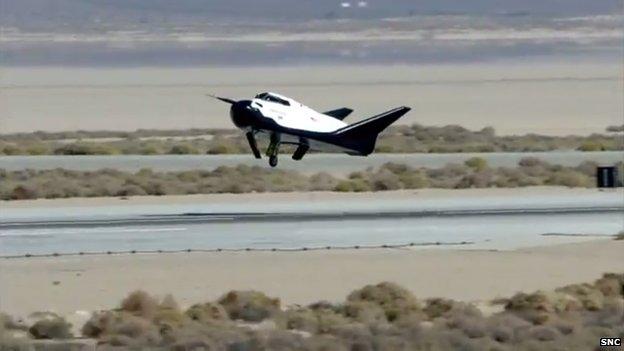Dream Chaser mini-shuttle given 2016 launch date
- Published

An artist's impression of the Dream Chaser atop its Atlas rocket, ready for launch
The Sierra Nevada Corporation (SNC) has set 1 November, 2016, for the debut flight of its space shuttle replacement.
Known as the Dream Chaser, the winged vehicle will launch atop an Atlas V from Florida's Kennedy Space Centre.
Though smaller than Nasa's famous orbiters, the Dream Chaser has still been designed to carry up to seven astronauts into low-Earth orbit.
The maiden voyage, however, will be an unmanned, autonomous flight.
The re-usable "lifting body" will spend about a day in orbit before returning to a landing strip on the US West Coast.
If all goes well, SNC hopes to mount its first manned mission in 2017.
And, ultimately, the Dream Chaser will land back at Kennedy on the same runway as used by the shuttles, and be serviced in Kennedy's processing facilities.
The date for the demonstration flight was announced in a joint media conference that included representatives from SNC, the US space agency (Nasa), and United Launch Alliance (ULA), which operates the Atlas rocket.
The 9m-long Dream Chaser is one of the three commercial human transportation systems currently being developed with the financial and technical support of Nasa.
The other two are more traditional capsule designs known as CST-100 and Dragon, from the Boeing and SpaceX companies respectively.

This impression gives a sense of the difference in scale between Dream Chaser and the shuttle
Nasa is likely to concentrate its resources on two, perhaps even only one, of these systems from late this year as it seeks to restore America's capability to launch its own astronauts into space. This capability was lost when the shuttles were retired in 2011 and sent to museums.
Today, all US personnel travel to the International Space Station in Russian Soyuz capsules, with each seat costing US taxpayers about $60m.
The three American companies say their indigenous vehicles will be much cheaper to operate.
SNC is insistent that development of the Dream Chaser will continue even if it misses out on Nasa's next round of seed funding.
"We are building the vehicle to be launched, and we have made a commitment to the launch," said SNC's Mark Sirangelo.
"[This first launch] is a direct relationship between Sierra Nevada and ULA, and Sierra Nevada is paying for the efforts of this; it's unconnected to the Nasa programme - the purchase of the launch was something done from company to company."
Two weeks ago, SNC announced tie-ups with the European and German space agencies that may lead to certain components and materials on future vehicles being sourced from across the Atlantic.

A full-sized model of the Dream Chaser has begun flight tests
Jonathan.Amos-INTERNET@bbc.co.uk and follow me on Twitter: @BBCAmos, external
- Published29 September 2013
- Published10 January 2013
- Published3 August 2012